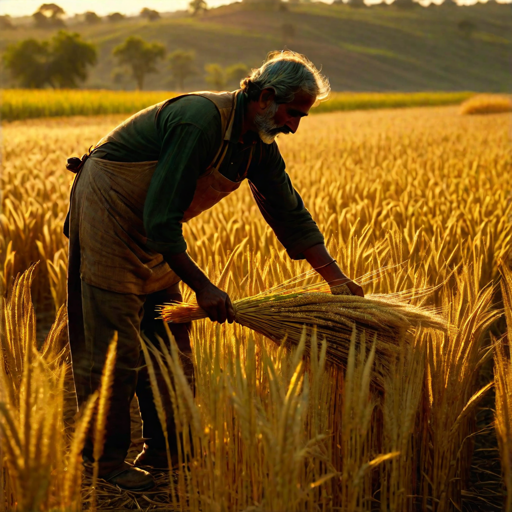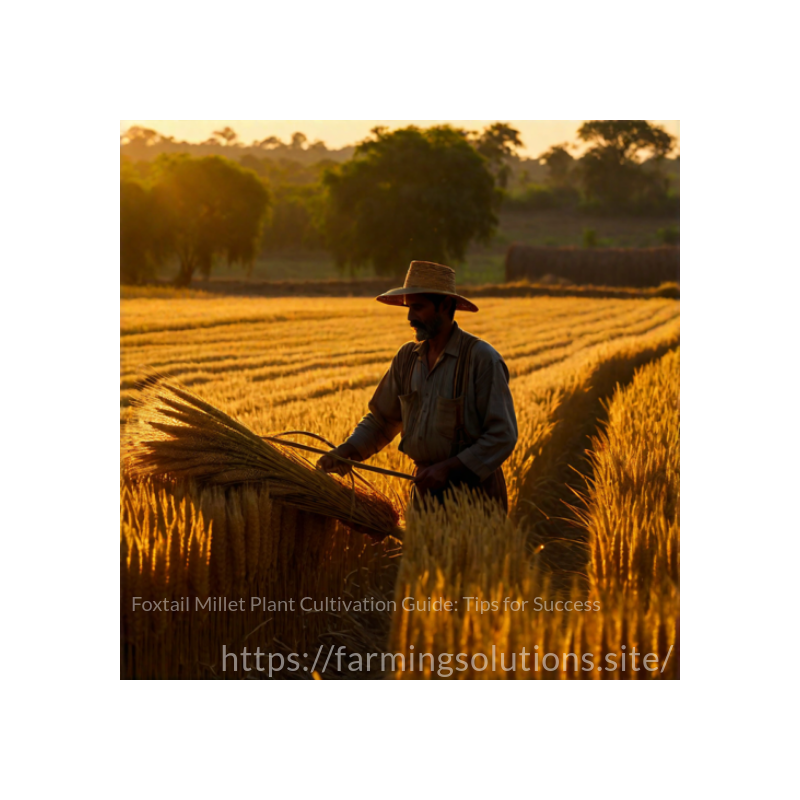
Foxtail millet, scientifically known as Setaria italica, is a versatile and nutritious grain that has gained popularity in recent years. Cultivating foxtail millet can be a rewarding experience, providing you with a sustainable source of food. This comprehensive guide aims to walk you through the essential steps and tips for successful foxtail millet plant cultivation. Explore effective techniques for foxtail millet plant cultivation. Our comprehensive guide provides valuable tips for successful foxtail millet farming. Start your cultivation journey today!

Foxtail millet is a warm-season annual grass that belongs to the Poaceae family. It is characterized by its slender, vertical growth and distinctive seed head, resembling a fox's tail. This grain has been a staple in many parts of the world due to its resilience and nutritional value.
Elegance in Growth: Picture the landscape adorned with slender, vertical blades that sway in the gentle breeze – that's the enchanting presence of Foxtail Millet. With an elegant stature, it stands as a testament to the artistry of nature, its slender form reminiscent of a fox's tail.
Distinctive Seed Head: Behold the distinctive seed head, the pièce de résistance of this remarkable grain. Resembling the tail of a fox, it adds a touch of whimsy to the agricultural canvas. It's not just a crop; it's a visual ode to the creativity embedded in the natural world.
Staple Resilience: Across the globe, Foxtail Millet has been a reliable staple, standing resilient in the face of diverse climates and challenging conditions. Its ability to thrive in warm seasons makes it a beacon of sustenance, providing communities with a steadfast source of nutrition.
Nutritional Bounty: Beyond its aesthetic charm and resilience, Foxtail Millet boasts a rich nutritional profile. Packed with essential nutrients, it has been a source of vitality for many, offering a wholesome grain option that contributes to a well-rounded and nourishing diet.
As you delve into the allure of Foxtail Millet, you uncover not just a grass but a narrative of elegance, resilience, and sustenance. It's a grain that gracefully intertwines with the human story, providing both visual poetry and nutritional abundance to those who cultivate and savor its unique offerings.
Before diving into foxtail millet cultivation, it's crucial to choose an appropriate location. Foxtail millet thrives in warm climates with well-drained soil. Ensure the selected area receives plenty of sunlight for optimal growth.

Embark on the artful journey of managing Foxtail Millet growth, where each step becomes a brushstroke in the canvas of cultivation, promising not just abundance but a harmonious symphony of agricultural mastery.
Strategic Sowing: Begin your millet odyssey with strategic sowing, selecting the optimal time and season. As you delicately place the seeds into the fertile soil, envision the potential of each tiny kernel, a precursor to the verdant tapestry that will soon grace your fields.
Watering Wisdom: Navigate the delicate balance of hydration with watering wisdom. Foxtail Millet, with its thirst for vitality, thrives on consistent moisture. Become the steward of a well-tuned irrigation dance, ensuring the soil is kept consistently moist without succumbing to waterlogged woes.
Nutrient Nurturing: Elevate your millet haven with nutrient nurturing. Implement a well-rounded fertilization plan, enriching the soil with the essential elements that coax Foxtail Millet to reach for the skies. Witness the transformation as the plants embrace the nutrients, painting the landscape with vibrant green hues.
Weed Whispering: In the choreography of growth, become the weed whisperer. With a discerning eye, meticulously remove any intruders that dare to encroach upon the millet haven. Allow your Foxtail Millet to bask in undisturbed splendor, unfurling its graceful panicles in the breeze.
Harvest Symphony: As the crescendo approaches, orchestrate the harvest symphony. Time your reaping with precision, when the millet heads bow with the weight of ripeness. With each sheaf gathered, you reap not just grains but the culmination of your dedication to managing Foxtail Millet growth.
In the realm of millet cultivation, you are not merely a farmer but a maestro, orchestrating a masterpiece where every element harmonizes to yield not just a crop, but a testament to the artistry of mindful cultivation.
Embark on the journey of cultivating Foxtail Millet, where the lush fields weave tales of resilience and the delicate balance of nature. As you nurture this ancient grain, the symphony of growth encounters its counterparts—pests and diseases. Here's a captivating glimpse into dealing with these challenges:
Guardianship Against Pests: In the enchanting fields of Foxtail Millet, vigilant guardianship becomes the art. Watchful eyes scan the swaying strands for potential invaders, be it aphids or mites seeking to disrupt the harmonious growth. Embrace the wisdom of organic pest control, where gentle interventions shield the golden grains without compromising the natural vitality of the fields.
Fending off Fungal Foes: Fungal diseases, subtle yet formidable, dance in the breeze, waiting for an opportunity to cast shadows on the vibrant greenery. Navigate this delicate dance by avoiding the pitfalls of overwatering, allowing the millet to breathe freely. In the heart of these fields, good air circulation becomes a shield, deflecting the whispers of fungal foes and preserving the pristine beauty of your crop.
Cultivating Resilience: As a steward of Foxtail Millet, you become a cultivator of resilience. Intertwine your efforts with the natural vitality of the fields, creating an environment where the grains not only withstand challenges but flourish. It's a delicate dance, where mindful practices and a touch of organic wisdom foster an ecosystem that thrives in the face of adversity.
In this captivating tale of Foxtail Millet, dealing with pests and diseases becomes a chapter of harmony and triumph. The fields, once touched by challenges, stand resilient, with golden grains whispering stories of overcoming obstacles and embracing the bounty of a well-nurtured harvest.
Embark on the fascinating finale of the foxtail millet cultivation journey—a tapestry woven with golden hues and the promise of sustenance.
Harvesting Elegance: As the sun-kissed fields of foxtail millet sway in the breeze, the time for harvesting arrives like a celebration of nature's abundance. The golden panicles, heavy with ripened grains, nod in agreement with the wind, signaling the peak of readiness. With a choreography of skilled hands, the harvest unfolds, a dance between farmer and field.
Timing is Art: The art of foxtail millet harvesting lies in impeccable timing. Optimal ripeness is key; the grains should be firm and plump, yielding a satisfying crunch between fingertips. The sun, casting its warm glow, becomes a partner in this delicate ballet, ensuring a harvest at the pinnacle of flavor and nutritional richness.
Storage Symphony: With the bounty cradled in the arms of those who toil the land, the symphony continues in the storage chambers. Gentle hands carefully store the harvested foxtail millet, securing its essence for future feasts. Properly dried and stored in a cool, dark sanctuary, the grains await their moment, preserving the golden harvest for nourishing meals throughout the seasons.
Promise of Sustenance: In every foxtail millet grain lies the promise of sustenance. The harvested and stored yield represents not just the fruits of labor but the embodiment of a cycle—the cycle of growth, harvest, and renewal. As the grains rest in their storage sanctuary, they carry the whispers of the fields and the dedication of those who tended to their growth.
In the dance of foxtail millet harvesting and storage, a tale unfolds—a tale of abundance, precision, and the eternal promise of wholesome nourishment.

Foxtail millet stands out due to its nutritional richness, gluten-free nature, and ability to thrive in challenging environments with minimal water resources.
Foxtail millet is well-suited for warm climates. Its adaptability allows it to flourish in diverse conditions, making it a versatile choice for cultivation.
Optimal harvests result from selecting quality seeds, providing well-drained soil, and following proper watering and fertilization practices throughout the growth stages.
Yes, consider using compost as an organic fertilizer. It enhances soil fertility naturally, promoting healthy foxtail millet growth.
Keep an eye out for birds, aphids, and mites. Implement protective measures like netting and natural remedies such as insecticidal soap.
While foxtail millet traditionally thrives in open fields, innovative cultivation techniques, such as container gardening, can be explored for limited space scenarios.
Yes, rotating crops helps reduce the risk of diseases like bacterial blight. Combine this with disease-resistant seed varieties for a more robust approach.
Water in the morning to facilitate proper absorption and reduce the risk of fungal diseases. Avoid waterlogging, especially during the flowering stage.
Absolutely! Foxtail millet is a naturally gluten-free grain, making it an excellent choice for individuals with gluten sensitivities.
Harvest when the seeds are fully mature and the plant has turned golden brown. Using sharp shears, cut the seed heads and bundle them for drying.
Properly dried foxtail millet can be stored for an extended period. Ensure airtight containers and a cool, dark storage space to maintain its quality.
Absolutely! Foxtail millet's resilience, minimal water requirements, and nutritional value make it an excellent choice for sustainable and eco-friendly farming practices.
In conclusion, embarking on the journey of foxtail millet cultivation is not just about growing a crop; it's about fostering a connection with nature and reaping the rewards of your dedication. As you witness the golden fields of mature foxtail millet swaying in the breeze, you'll not only have a bountiful harvest but a sense of accomplishment that comes with nurturing a resilient and nutritious grain.
The versatility of foxtail millet, from its gluten-free nature to its adaptability to various climates, makes it a standout choice for those seeking a sustainable and health-conscious agricultural venture. By carefully following the outlined cultivation tips, you not only ensure a successful harvest but also contribute to the broader movement of promoting nutritious and eco-friendly food choices.
So, let the fields of foxtail millet not only signify agricultural abundance but also a step towards a more sustainable and healthier future. As you enjoy the fruits of your labor, may the satisfaction of cultivating this exceptional grain inspire others to join the journey of fostering a deeper connection with the land and savoring the rewards it generously offers. Happy cultivating!
Note : If you want to know and ask more questions about agriculture, you can contact here

Copyright 2024 Farming Solutions